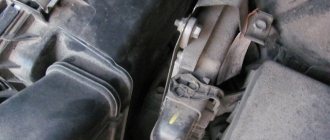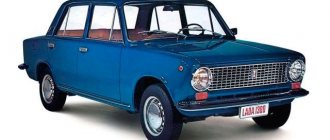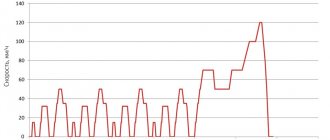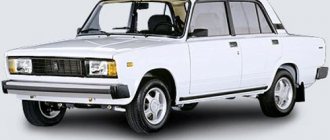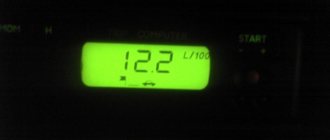VAZ 2106 is a domestic car, which is known for its durability and stability. Fortunately, all domestic cars have one big advantage - the fuel consumption of the VAZ 2106 is not high, which makes such a purchase even more successful. Of course, fuel consumption standards for the Lada 2106 in the city significantly exceed fuel consumption on the highway. The reason for this is that in the city the car is not at a stable speed, it stops, slows down, etc., such work consumes more energy.
Official data (l/km)
| Engine | Consumption (city) | Consumption (highway) | Flow (mixed) |
| 1.3 MT 64 hp (Mechanics) | 9.5 | 7.6 | 8.3 |
| 1.5 MT 72 hp (Mechanics) | 9.8 | 8.0 | 8.8 |
| 1.6 MT 74 hp (Mechanics) | 10.3 | 7.4 | 9.1 |
| 1.6 MT 75 hp (Mechanics) | 10.3 | 7.4 | 9.1 |
| 1.6 MT 75 hp (Mechanics) | 10.1 | 7.4 | 9.0 |
The first, smallest engine was the 1.3 liter version. At most, such an engine could produce a power of 64 horsepower. Its fuel consumption per 100 km was 9.1 liters in the city and 7.5 liters on the highway. Next came an engine with a displacement of 1.5 liters. He was already capable of squeezing out 72 horsepower while consuming 8.5 liters of fuel. The largest engine was a 1.6 liter unit, the power of which was 75 horsepower. This engine was already consuming 8.9 liters of gasoline. Fuel injection on all versions was carried out by a carburetor, and the transmission was only a four-speed manual.
This is interesting: What is the fuel consumption of the Lada Vesta
VAZ 2131
This car is better known as Niva 2131. Initially, such cars, built on the basis of the Niva 2121, but with a longer body, were intended for export. But due to their good cross-country ability and relatively low price, they have gained popularity in the domestic market. Production of the VAZ 2131 started in 1993 and continued until 2021, when it was replaced by a newer version, the Lada 4×4 Urban. The VAZ 2131 was equipped with one of five gasoline engines or a diesel power unit.
| Engine | Consumption (city) | Consumption (highway) | Flow (mixed) | Type of fuel |
| 1.7 MT 79 hp | 13.7 | 9.8 | 12.0 | Petrol |
| 1.7 MT 80 hp | 13.7 | 9.8 | 12.0 | |
| 1.7 MT 83 hp | 13.7 | 9.8 | 12.0 | |
| 1.8 MT 82 hp | 13.8 | 12.0 | 13.2 | |
| 1.8 MT 84 hp | 13.8 | 12.0 | 13.2 | |
| 1.9 MT 50 hp | 9.7 | 6.8 | 7.6 | Diesel |
The actual fuel consumption of VAZ models per 100 km may differ from the standard data specified in the tables, and it can only be determined experimentally. It is important to remember that average fuel consumption can differ significantly in winter and summer. If fuel consumption is much higher than the average values given in the tables, the car must be taken to a mechanic service station and, after determining all the factors of increased consumption, it may be worth switching it to gas.
Engines and official fuel consumption rates of the VAZ-2106
Over the entire production period, the “six” was equipped with three variants of gasoline engines with a carburetor and a manual transmission with rear-wheel drive. Their advantages include:
- reliability;
- unpretentiousness;
- simplicity of design;
- low cost of repairs;
- economical fuel consumption of VAZ-2106.
The first version to appear was a 1.3 engine with 64 horsepower. With it, the “six” accelerated to the first hundred in 18 seconds, and the maximum speed reached 145 kilometers per hour. The car had the following fuel consumption figures per 100 kilometers:
- city mode 9.5 l;
- on the highway 7.6 l;
- mixed mode 8.3 l.
To meet the needs of potential buyers, they were offered a more powerful version with a 1.5 petrol unit and a power of 72 horses, a five-speed manual transmission. In this configuration, the VAZ-2106 accelerated to a maximum of 150 km/h, and reached the first hundred in 17 seconds. These figures were achieved with the following gasoline consumption per hundred kilometers:
- city 9.8 liters;
- track 8 liters;
- the average is 8.8 liters.
The most powerful and beloved by domestic car enthusiasts was the modification with a 1.6 engine with 75 horsepower - a reliable, dynamic unit. Paired with a balanced five-speed manual transmission, it accelerated the car to 155 kilometers per hour, and the dynamic acceleration to hundreds became 16 seconds. At the same time, fuel consumption per hundred increased slightly and amounted to:
- in city traffic 10.3 l;
- mixed mode 9.1 l;
- on a free road 7.4 liters.
All engines are designed for AI 92 gasoline, but can also run on other brands, both with lower and higher octane numbers.
What is the fuel consumption per 100 km of the VAZ-2106
To find out what fuel consumption a VAZ-2106 has for every 100 km, you need to know what engine size your car has. This car model is released in three different variations. Fuel consumption varies depending on this indicator:
- If the engine capacity is 1600 cm 3: when driving in the city, fuel consumption is 13 liters per 100 km, on the highway - 8 liters per 100 km.
- If the engine capacity is 1300 cm 3: in the city - 10 liters, on the highway - 7.8 liters per 100 km.
- If the engine capacity is 1500 cm 3: in the city - 11-12 liters, on the highway - 7.9 liters per 100 km.
It is worth considering that actual performance may vary depending on the type and quality of fuel used, as well as the type of gearbox. On average, the gasoline consumption of any “six” is 8 liters. If you have a gas car, your highway consumption will be 13 liters per 100 km. In winter, the amount of fuel consumed increases. By modern standards, the VAZ-2106 has high consumption. At the same time, many owners of such cars often face the problem of increased consumption. The question arises: how to reduce gasoline or gas consumption?
Fuel consumption VAZ 1.3l.
The VAZ 2106 was equipped with a five-speed gearbox and a gasoline carburetor engine with a displacement of 1300 cc. and power 64 hp. The car has a top speed of 145 km/h and accelerates from zero to hundreds in 18 minutes. Fuel consumption within the city is 9.5 liters, and on the highway – 7.6-8 liters per hundred kilometers.
Real fuel consumption of VAZ 2106 1.3l.
- Andrey. Kirov. I inherited a VAZ 2106 produced in 1992 from my father. This was five years ago. Of course, at that time there were practically no “original” spare parts in the car, but the engine worked “like a clock” and never let me down. If you don’t press the gas pedal to the floor on the highway and warm up the car thoroughly in winter, then there will be no problems with it. I think that a domestically assembled engine, with proper and timely maintenance, will last for many more decades. As for fuel consumption, my 1.3 liter engine “eats” about ten liters in the city, and on the highway – within seven liters per hundred.
- Oleg. Tomsk I bought a VAZ 2106 from a neighbor in 2005 with a 1.3-liter engine. The car came off the assembly line back in 1988, so you understand that its condition was not the best. I overhauled the engine, replaced all consumables, slightly modernized the interior and drove it without problems for five years. I was also completely satisfied with fuel consumption: in the city no more than ten liters, and on the highway during normal driving it was possible to keep within 7.5-8 liters.
- Sergey. Adler. I bought a VAZ 2106 from 1985 specifically for taxi work. The previous owner loved his car, so I got it in very good condition. I drove the “Six” for almost seven years and during this time it did not create any special problems for me. If we talk about fuel consumption, then I got about ten liters in the city and eight on the highway.
- Vladimir. Kazan. The VAZ 2106 with a 1.3-liter engine is a good domestic car that, with proper care, can faithfully serve for several decades. I bought my ’85 “six” in 2001 in order to take my family to the dacha and visit relatives. In addition, I also drove the car for work, so it rarely came into my garage. During the entire period of operation, I never looked into the engine, since there was no need for this, it worked properly and did not let me down. In terms of fuel consumption: in the city with normal traffic it was up to ten liters, and on the highway - 8-8.5 liters per hundred.
- Alexei. Ulyanovsk VAZ 2106 1.3 liter - this is my first car. I bought it new off the production line in 2001 and drove it for almost ten years. Of course, immediately after the purchase I had to tighten up a few things and blow out the bottom, but otherwise I had no complaints about the car. The machine is a real “workhorse”; I have no doubts about this during the entire time I used it. In terms of consumption, I can say the following: in the city I got from eight to ten liters, and on the highway (if I didn’t press the accelerator pedal to the floor) - 8-8.5 liters per hundred kilometers.
VAZ-2105 owner reviews
With 1.3 engine
- Maxim, St. Petersburg. I have a 1980 six, a good everyday workhorse. Simple and easy to maintain, my dear swallow. Of course, I service it myself, fortunately I still have my father’s garage with the necessary spare parts. The machine does not require qualified repairs; just take a manual. And of course, this requires straight hands, certainly not without it. The six is equipped with a 1.3-liter engine and mechanics that work as smoothly as a clock. The average gasoline consumption per 100 km is 7-8 liters, I fill it with 92.
- Anatoly, Nikolaev. I liked the car, it would be suitable for the role of a first car. I have the 1.3-liter version, with a manual transmission. I bought it together with a trailer - I'm a big business owner. The car consumes 8-9 liters.
- Sergey, Nizhny Novgorod region. The car is awesome, I'm quite happy with it - durable and inexpensive to maintain, I sat down and drove off as they say. Spare parts are inexpensive, I carry them with me in the trunk - a common thing for a pelvis. Consumption 8 liters.
- Yuri, Dnepropetrovsk. I'm happy with the car, a car for all occasions. If you don’t pick too much, then this can be said to be a universal car. At least, together with the VAZ-2106 you can drive on any roads, even on light off-road conditions. The Shahi's suspension is soft and energy-intensive, and is not afraid of breakdowns and potholes. Spacious trunk and interior, clear controls. Everything is so simple that, it would seem, there is nothing to break here. Alas, there are problems, but I attribute them to being 20 years old. The car consumes 8 liters per 100 km.
With 1.5 engine
- Alexander, Lipetsk. VAZ-2106 satisfies all my needs - both in the family and at work. I bought it in 2005, in new condition. I've driven 166 thousand km, everything works stably, with a 1.5-liter engine you can achieve 8-9 liters.
- Yaroslav, Nizhny Novgorod. A good car, a worthy representative of the Soviet automobile industry. But I wouldn’t be upset if it had been taken off the production line during the USSR, and then I definitely wouldn’t have bought it. And so, I have a shah purely for the dacha and various household needs, that’s where it belongs. Consumption 8 l.
- Anton, St. Petersburg. I have a VAZ-2106 with a 1.5-liter unit. Quite a powerful and dynamic car. In addition, what helps the six accelerate quickly is not so much the engine as the lightweight design. I studied the model, consider the body of my shahi to be empty, without any security. Well, that's true, if you're being too picky. But the VAZ will work purely for the city. The car handles well in city traffic and never lags behind. And if anything can be piled up at traffic lights. The 1.6 engine consumes 8-9 liters per 100 km.
- Alexey, Krasnoyarsk. A great car for a beginner, for undemanding guys with straight arms. In principle, any novice driver, even one who does not understand the structure of a car, can handle the six. We buy an instruction manual and go ahead. My car consumes 8 liters.
- Karina, Sochi. I got the six from my grandfather, I drive calmly and leisurely. The VAZ-2106 is a normal car if you use it around the city, don’t drive fast, follow traffic rules and service it on time. I have a 1.5-liter version, it consumes 8-9 liters.
- David, Arkhangelsk. My VAZ-2106 is equipped with a 1.5-liter engine with a preheater. The car is warm and cozy, which is very pleasing. I drive calmly, just to get to work and back home. Average consumption is 7-9 liters.
- Dmitry, Magnitogorsk. The car is awesome, it suits me in almost all respects. Firstly, it is completely adaptable to Russian roads and climate. The engine starts with half a turn even in cold weather, and I also praise the energy-intensive chassis and the precise operation of the gearbox. The steering wheel is empty, although shortcomings in handling are noticeable only at high speeds. But I’m not afraid of this, since I mostly ride around the city. Average consumption is 9 liters per 100 km, I fill with 92nd gasoline.
With 1.6 engine
- Vasily, Irkutsk. Shah pleased me, a solid and unpretentious car, it pleases the eyes of me, my wife and our children. A good family car. There were no problems with installing child seats, everything was fine. Average consumption is 9-10 liters with a 1.6-liter engine.
- Svetlana, Novosibirsk. I like how the VAZ-2106 overcomes our broken roads, as if like a bulldozer. No speed bumps are scary for him. I have a 1.6-liter version, it consumes 9 liters/100 km.
- Andrey, Yaroslavl. The car is fire, I have a 1.6-liter modification. A six with such an engine is a very dynamic vehicle, capable of keeping up even with foreign cars, if, of course, you try hard. In addition, the car has great potential for tuning. I bought the car in 2006, in the last year of its production life. It's called successful. All the same, the car is worth the money, although until recently I doubted this bucket of bolts. A 1.6-liter engine with manual transmission consumes 9-10 liters in the city.
- Konstantin, Moscow region. I like the car, it’s a great option for traveling around the city and to the country. The mechanics and 1.6-liter engine work as they should, they have optimal acceleration dynamics. There is something similar in no other car for that kind of money. The six accelerates and brakes quickly, consumes 10 liters per hundred.
- Nikolay, St. Petersburg. A car for all occasions, equipped with a 1.6-liter gasoline engine, very modern by the standards of that time. But it is not entirely clear why the six were produced until 2006. And they bought it, including me. Oh, how I regretted it, oh, how I regretted it. Breakdowns are a dime a dozen, I no longer have time to go to the service station every time. Still, people are right when they say that it is better to service such cars in your own garage. The car consumes 10 liters per hundred.
- Sergey, Ryazan. I have owned the VAZ-2106 for five years now, and my husband and I drive comfortably. We have a seven with a 1.6-liter engine, a reliable and unpretentious car, with a mileage of 125 thousand km. Consumes 9-10 liters per 100 km.
- Alexey, Bryansk. I liked the six, I serve it myself. By the way, this is my first car. I made it a habit to check my car every morning before leaving. And as a result, no problems on the road. Consumption is 9 liters, under the hood is a 1.6-liter engine.
- Vitaly, Orenburg. A great car for the city, comfortable and soft. If you drive fast, there will be noticeable roll in corners, but this is not critical. In addition, the six is designed for a quiet ride. At least I try not to exceed 70-80 km/h. A VAZ-2106 with a 1.6-liter engine consumes 10 liters. It is possible to fill with 92nd gasoline. I praise the car for its impenetrable suspension. Still, the chassis of the car is very durable, so to speak, for centuries. But the design and reliability of the car leave much to be desired.
With HBO (on gas)
- Andrey, Vologda region. I'm happy with the car, the car suits me in all respects. I have a gas version based on a 1.6-liter engine. The dynamics have disappeared a little, but this is not significant compared to the advantages that the ability to drive on gas brings. Consumption has remained almost unchanged and is 9-10 liters, but costs have been reduced by almost half. The car is used as a taxi.
- Dmitry, Tver region. The car is worth the money, I have a 1.6-liter version with gas equipment. Consumes 11 liters, and I think this is acceptable for this class, taking into account the age of the car.
- Oleg, Kaliningrad. My gas VAZ-2106 has covered 98 thousand miles. Everything seems to be fine, but the smell of gas in the cabin is annoying, especially when I press it to the floor. You have to open the windows, otherwise you might suffocate, no problem. Average consumption is 8-9 liters.
- Nina, Krasnodar region. This is my favorite car, an indispensable assistant in household matters. The gas 1.6-liter engine allows you to save money on the operation of the six. In the city the car consumes 8-10 liters.
- Oleg, Perm region. VAZ-2106 is a very unpretentious and durable city car, I bought it for working as a taxi. The car is from 2006 and I still drive it. Despite the mileage of 180 thousand km, I am satisfied with the car. It is easy to maintain, and many breakdowns can be solved even in the middle of the road, as long as you have the necessary set of tools at hand. I have a 1.5 liter version with gas. In the city you can keep within 10 liters, on the highway it turns out to be 7-8 liters per 100 km.
Outdated carburetor models of Zhiguli are not very economical. According to the passport specifications, the VAZ 2106 consumes 9–10 liters of A-92 gasoline per 100 km in the urban driving cycle. Real consumption, especially in winter, exceeds 11 liters. Since the price of fuel is constantly rising, the owner of the “six” is faced with the difficult task of minimizing fuel consumption by all available means.
Technical characteristics of Lada
If we talk specifically about the VAZ 2106, then this car fully corresponds to its price category, it is equipped with everything necessary, and has an attractive design.
The VAZ 2106's gasoline consumption per 100 km is low, about 7 liters on the highway, and about 10 liters in the city
. This is normal consumption for a car with such power, but it is worth noting that such fuel consumption of 2106 per 100 km is beyond the means of many car enthusiasts.
To avoid problems with servicing your VAZ 2106, you should pay attention to some things even when purchasing it:
- The price of the car itself;
- The approximate price you are willing to spend on its maintenance per year;
- Approximate cost of gasoline for a car per month;
- Unplanned capital investments;
Only by calculating the approximate costs of it for a year, and correlating it with your capabilities, can you determine your chances of properly servicing such a car.
Fuel consumption on a carburetor VAZ 2106 also does not exceed the norm, and is not particularly different from the usual consumption of this VAZ, because the volume of gasoline burned can fluctuate, depending on many factors: weather conditions, the condition of the car, driving habits, the quality of gasoline and oil.
If you have already decided to buy this car, but are not informed about possible or frequent breakdowns of this model, its weak points and the real fuel consumption of the VAZ 21063 - then experienced motorists, former owners of a VAZ of this model or just experienced auto mechanics.
Only after consulting with them, you will be able to make the right decision, or, perhaps, you will be insured against unpleasant situations and possible breakdowns.
This is interesting: What should be the gas consumption for a VAZ 2110
Diagnosis and resolution of technical problems
A serious increase in fuel consumption never occurs without reason. The “culprit” is often detected by the following signs:
- drop in engine power, noticeable deterioration in traction and acceleration dynamics;
- the appearance of the smell of gasoline in the car interior;
- idle failure;
- jerks and dips during movement;
- the engine suddenly stalls while driving;
- at idle, the crankshaft speed “floats”;
- The smell of burnt pads and noise from increased friction can be heard from the wheels.
The listed symptoms may indicate one or more technical problems. To save fuel, learn to quickly recognize the source of a malfunction and promptly fix the problem - yourself or at a service station.
Cylinder piston and valve group
Natural wear of pistons and rings causes the following consequences:
- A gap is formed between the walls of the cylinders and pistons, into which gases from the combustion chamber penetrate. Passing through the crankcase, exhaust gases are sent through the ventilation system for afterburning, contaminating the carburetor air jets and excessively enriching the fuel mixture. Gases penetrate through the gap around the worn piston, and the compression of the combustible mixture deteriorates
- Compression drops and gasoline combustion conditions worsen. To develop the required power, the engine begins to consume more fuel, and the lion's share of unburned fuel is thrown out through the exhaust tract.
- Motor oil penetrates into the combustion chambers, aggravating the situation. A layer of carbon deposits on the walls and electrodes causes overheating of the cylinder head.
Critical wear of the cylinder-piston group increases fuel consumption by 20-40%. Valve burnout leads to complete failure of the cylinder and an increase in flow rate by 25%. When 2 cylinders are switched off in a VAZ 2106 engine, gasoline losses reach 50%, and the car practically “does not move.”
A burnt-out valve allows gases to pass in both directions, the pressure drops to zero and the cylinder completely fails.
How to check the motor for wear:
- Pay attention to the color of the exhaust - oil fumes produce thick bluish smoke.
- Disconnect the crankcase ventilation pipe from the air filter housing and start the engine. If the compression rings are worn out, a bluish exhaust will come out of the hose.
- Measure compression in all cylinders while hot. The minimum acceptable value is 8.5-9 Bar.
- If the pressure gauge shows 1-3 bar pressure in the cylinder, the valve (or several valves) has become unusable.
Thick, bluish-colored exhaust indicates waste of engine oil and wear of the piston group.
To finally make sure that the valve is burned out, pour 10 ml of motor lubricant inside the cylinder and repeat the compression measurement. If the pressure rises, change the rings and pistons; if the pressure remains unchanged, throw away the valves.
Zero readings on the pressure gauge indicate a leak in the cylinder due to a burnt-out valve.
The wear of elements and the “gluttony” of the engine can be treated in the only way - major repairs and replacement of unusable parts. The final verdict is made after disassembling the power unit - perhaps it will be possible to save money by changing only the valves and rings.
- Fuel consumption Niva
Video: how to measure compression in cylinders of a VAZ 2106
Fuel supply system
Problems in this group cause excess fuel consumption of 10-30%, depending on the specific problem. The most common breakdowns:
- increased fuel level in the carburetor float chamber;
- clogging of air jets (one of the reasons is stated above);
- abrasion of the throttle valves - gaps form at the edges, from where the engine sucks in fuel due to vacuum;
- unqualified carburetor adjustment - violation of the settings of the support and fuel screws;
- air leaks on the intake manifold flange or on the throttle valve axles;
- breakthrough of the lower diaphragm of the fuel pump.
If the car interior smells like gasoline: https://bumper.guru/klassicheskie-modeli-vaz/poleznoe/zapah-benzina-v-salone.html
The last malfunction is the most insidious. The pump pumps fuel in 2 directions - to the carburetor and into the engine crankcase through the drive rod. The oil dilutes, the pressure drops, gasoline vapors fill the intake manifold and greatly enrich the mixture, consumption increases by 10-15%. How to detect: remove the breather tube with the engine running and carefully sniff the gases. A strong smell of fuel will immediately indicate a malfunction.
If there is gasoline in the crankcase, smoke with a pungent odor will come out of the removed pipe.
Another way to check the carburetor is to tighten the “quality” screw with the engine running. Turn the regulator with a screwdriver and count the revolutions - at the end the engine should stall. If the power unit continues to operate with the screw tightened, it means that fuel enters the manifold directly. The carburetor must be removed, cleaned and adjusted.
If the “six” engine stalls safely, turn the screw back to the calculated number of revolutions
Do not try to save money by replacing standard carburetor jets with parts with a smaller flow area. The fuel mixture will become lean, the car will lose dynamics and power. You will increase your consumption yourself - you will begin to press the accelerator pedal more intensely.
Replacing the fuel pump membrane is not difficult:
- Disconnect the fuel hoses.
- Unscrew the 2 fastening nuts with a 13 mm wrench. The Zhiguli fuel pump is screwed to the flange on the left side of the engine (in the direction of travel)
- Remove the pump from the studs and unscrew the housing with a screwdriver.
- Install 3 new membranes, assemble the unit and attach to the engine flange, replacing the cardboard gasket. The VAZ 2106 gasoline pump has 3 membranes, they are always replaced together
Video: setting up the Ozone carburetor
Ignition elements
Problems in the spark generation system also cause the power unit to consume excess fuel. Example: due to misfire, a portion of the combustible mixture drawn by the piston into the combustion chamber completely flies out into the pipe during the next cycle. There was no flash, no work was done, gasoline was wasted.
Common ignition system problems that cause excessive fuel consumption:
- Fuel consumption of the VAZ 2107: what it depends on and how to reduce it
- Failure of a spark plug leads to cylinder failure - plus 25% to fuel consumption.
- A breakdown of the insulation of high-voltage wires reduces the power of the spark, and the air-fuel mixture does not burn completely. The residues are pushed into the exhaust system manifold, where they can burn out without any benefit to the engine (popping noises are heard in the pipe).
- Sparking worsens due to malfunctions of the distributor parts - breakdown of the cover, burnout of the contact group, wear of the bearing. The mechanical contact group must be periodically cleaned and the gap adjusted to 0.4 mm
- When the membrane of the vacuum unit becomes unusable or the springs of the centrifugal regulator weaken, the ignition timing decreases. The spark is supplied late, engine power drops, and fuel consumption increases by 5-10%.
You should not remove the armor wire with your bare hands - put on a glove or use pliers
The best diagnostic method for an inexperienced driver is to replace the distributor or high-voltage cables. If there is no spare distributor in the garage, clean or change the contact group - the spare part is inexpensive. Bearing play is checked manually by rocking the turntable up and down. Diagnose the integrity of the vacuum unit membrane by drawing air through the tube leading to the carburetor.
Fuel consumption VAZ 1.5l.
VAZ 2106 1.5. It was equipped with a gasoline carburetor engine and a five-speed manual transmission. The engine displacement is 1452 cc and power is 72 hp. Engine torque is 104 Nm at 3400 rpm. The car has a top speed of 150 km/h and accelerates from zero to hundreds in 17 seconds. Fuel consumption VAZ 2106 1.5l. in the city it is 9.8 liters, on the highway - 7.4 liters per hundred kilometers.
Real fuel consumption of VAZ 2106 1.5l.
- Vladislav. Samara. Six years ago I bought a second-hand “six” with a one and a half liter engine for work and I drive it to this day. What can I say, in my opinion, this is the best car for our roads. In addition, considering that the car rolled off the assembly line back in 1988, its condition can be said to be ideal. If your head “cooks” and your hands grow from the right place, then you can use the “six” for more than a dozen years. In terms of gasoline consumption, my average is ten liters in the city and up to 8.5 on the highway.
- Dmitriy. Kazan. My “swallow”, after a major overhaul in 2001, still doesn’t drive, but flies! I completely overhauled the engine and gearbox, changed all the consumables and slightly modernized the interior. Since then there have been no major problems. In terms of gasoline consumption, I get about ten liters when driving around the city and no more than nine on the highway.
- Egor. Samara. I inherited my “six” with a one and a half liter engine from my father in 1995. My father loved the car very much and looked after it carefully. The machine served me faithfully for ten years, after which I sold it. It seems to me that for our expensive VAZ 2106 it is exactly what we need. The machine is stable, durable, convenient, and most importantly, not expensive to maintain. In terms of gasoline consumption, I got no more than 10 liters in the city (in normal traffic) and up to nine liters on the highway.
- Ivan. Saint Petersburg. I bought the car off the production line in 1993. Of course, for greater comfort and safety I had to tighten some parts and blow out the bottom, but otherwise I was completely satisfied with the car. Playful, easy to control and stable. In addition, the suspension is not very stiff, and the interior is spacious and comfortable. I sold my “six” five years ago and today I already regret it. The car “eats” relatively little, and maintenance costs pennies. My gasoline consumption averaged up to 10 liters within the city and 7.5-8 liters on the highway, which I think is quite normal.
- Victor. Kostroma. I bought a used 1993 Six from a work colleague. What can I say, the car is a real classic of the domestic automobile industry. A spirited engine, a relatively soft suspension, a comfortable interior that warms up quickly in winter. In addition, if the hands grow from the right place, then maintenance costs mere pennies. Fuel consumption is also within normal limits: in the city up to ten liters, and on the highway (if you don’t drive) you can keep within 7.5-8 liters per hundred kilometers.
- Nikita. Moscow. I bought a “six” second hand after a major overhaul. At that time, it already had 7,000 kilometers on it. Today the mileage is 25,000 km, and I still have no complaints about the machine. It picks up speed quickly, has good stability and controllability, and most importantly, is inexpensive to maintain. In terms of gasoline consumption, everything also suits me: in the city with heavy traffic it turns out to be up to ten liters, and on the highway with normal driving you can keep within 8 liters.
- Victor. Stavropol. It seems to me that the “six” with a one and a half liter engine is an ideal car for those who are just acquiring driving skills and are trying to figure out how everything works in the engine, gearbox, etc. The car is easy to control, stable and playful. I’ve been riding mine for five years now and I don’t have any particular complaints, although I bought it used. Gasoline consumption is also within normal limits: in the city I get no more than ten liters, and on the highway, if I don’t drive, it’s 7.5-8 liters.
- Natalia. Belgorod. My husband bought a VAZ 2106 from 1988 from a friend. He said that this is an ideal option for acquiring driving skills. And today I understand that he spoke the truth. We made a capital investment immediately after the purchase, and to this day we have no complaints about the machine. Of course, this is not a foreign car with climate control and leather seats, but the car is quite enough for everyday movement around the city. In terms of gasoline, I get about ten liters in the city and 8-8.5 on the highway.

